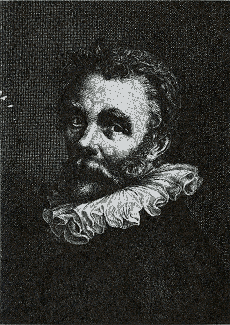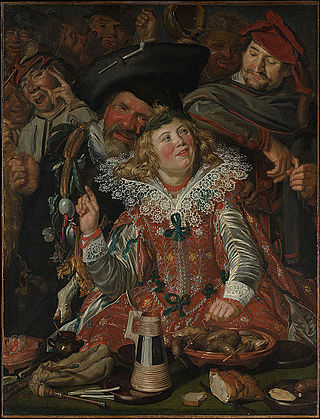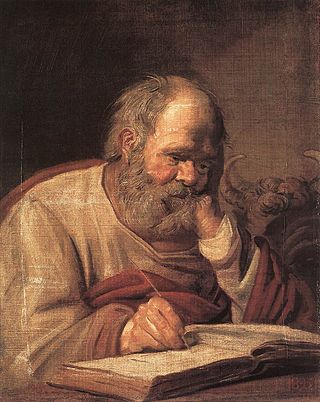
Frans Hals the Elder was a Dutch Golden Age painter, chiefly of individual and group portraits and of genre works, who lived and worked in Haarlem.

Cornelis or Cornelius Ketel was a Dutch Mannerist painter, active in Elizabethan London from 1573 to 1581, and in Amsterdam till his death. Ketel, known essentially as a portrait-painter, was also a poet and orator, and from 1595 a sculptor as well.

Malle Babbe is a painting by the Dutch Golden Age painter Frans Hals, painted c. 1633-1635, and now in the Gemäldegalerie, in Berlin. The painting has also been titled as Hille Bobbe or the Witch of Haarlem. It was traditionally interpreted as a tronie, or genre painting in a portrait format, depicting a mythic witch-figure. The painting is now often identified as a genre-style portrait of a specific individual from Haarlem, known as Malle Babbe, who may have been an alcoholic or suffered from a mental illness.
The Laughing Cavalier is a 1624 painting by Frans Hals in The Wallace Collection, London.

Tieleman Roosterman, was a Dutch cloth merchant and friend of Willem van Heythuysen. Roosterman is best remembered today for his portrait painted by Frans Hals.

Isabella Coymans, was the Dutch wife of Stephanus Geraerdts best known for her portrait painted by Frans Hals.

Pieter Biesboer, is a Dutch art historian and prolific writer on 17th-century Dutch art. His specialty is art from Haarlem.

Laughing Boy is a circular oil-on-panel painting by the Dutch artist Frans Hals. It belongs to the tronie genre and was painted around 1625. It is in the collection of the Mauritshuis.

Yonker Ramp and His Sweetheart is an oil-on-canvas painting by the Dutch Golden Age painter Frans Hals, painted in 1623 and now in the Metropolitan Museum of Art, New York City. The painting has also been titled as Young Man and Woman in an Inn or Portrait of Pieter Ramp.

Shrovetide Revellers, also known as Merrymakers at Shrovetide, is a painting by the Dutch Golden Age painter Frans Hals, painted in around 1616–17. It is one of the earliest surviving works by Hals, and has been held by the Metropolitan Museum of Art, New York City since 1913. The painting shows people festivities at Shrovetide, an annual carnival of food and jollity which takes place before the Christian fasting season of Lent.

Claes Duyst van Voorhout is an oil-on-canvas portrait painting by the Dutch Golden Age painter Frans Hals, painted in 1638 and now in the Metropolitan Museum of Art, New York City.

Young Man with a Skull is an oil on canvas painting by the Dutch Golden Age painter Frans Hals, created in 1626-1628, now in the National Gallery, in London. The painting was previously thought to be a depiction of Shakespeare's Hamlet holding the skull of Yorick, but is now considered to be a vanitas, a reminder of the precarious nature of life and the inevitability of death.

St. Luke is an oil-on-canvas painting by the Dutch Golden Age painter Frans Hals, painted in 1625 and now in the Odesa Museum of Western and Eastern Art.

St. Matthew is an oil-on-canvas painting by the Dutch Golden Age painter Frans Hals, painted in 1625 and now in the Odesa Museum of Western and Eastern Art, Odesa.

St. Mark is an oil-on-canvas painting by the Dutch Golden Age painter Frans Hals, painted in 1625. It was purchased by Russian philanthropist Alisher Usmanov from the art dealer Colnaghi, London in September 2013 for the Pushkin Museum and donated by him to that museum in November that year, where it still hangs.

Portrait of a Woman in a Chair is an oil-on-canvas painting by the Dutch Golden Age painter Frans Hals, painted in 1627 and now in the Art Institute of Chicago. It is considered a pendant portrait, but the sitter is unknown and therefore the pendant is not certain.

Portrait of Catharina Brugman is an oil-on-canvas painting by the Dutch Golden Age painter Frans Hals, painted in 1634 and now in a private collection. It is considered a pendant to the portrait of Catharina's husband Tieleman Roosterman.

The following is the list of 145 paintings indexed as autograph by Frans Hals, written by the art historian and Hals specialist Claus Grimm in 1989. The list is by catalogue number and is more or less in order of creation, starting from around 1610 when Hals began painting on his own. Most of these works are still considered autograph, though one has since been reattributed to Judith Leyster. In addition to this list, Grimm added comments and additional entries to Seymour Slive's lists of lost and doubtful paintings. He also rejected several Slive attributions, making his list is considerably shorter. The autograph catalogue entries are as follows:

Portrait of Stephan Geraedts, Husband of Isabella Coymans is an oil on canvas painting by Dutch Golden Age painter Frans Hals. The painting was originally part of a couple of pendant wedding portraits. Hals probably painted the present portrait, Stephanus Geraerdts', alderman in Haarlem, and the accompanying portrait of the latter's wife Isabella Coymans around 1650–1652, six or seven years after their marriage in 1644. Isabella's portrait is now in a private collection in Paris.


















